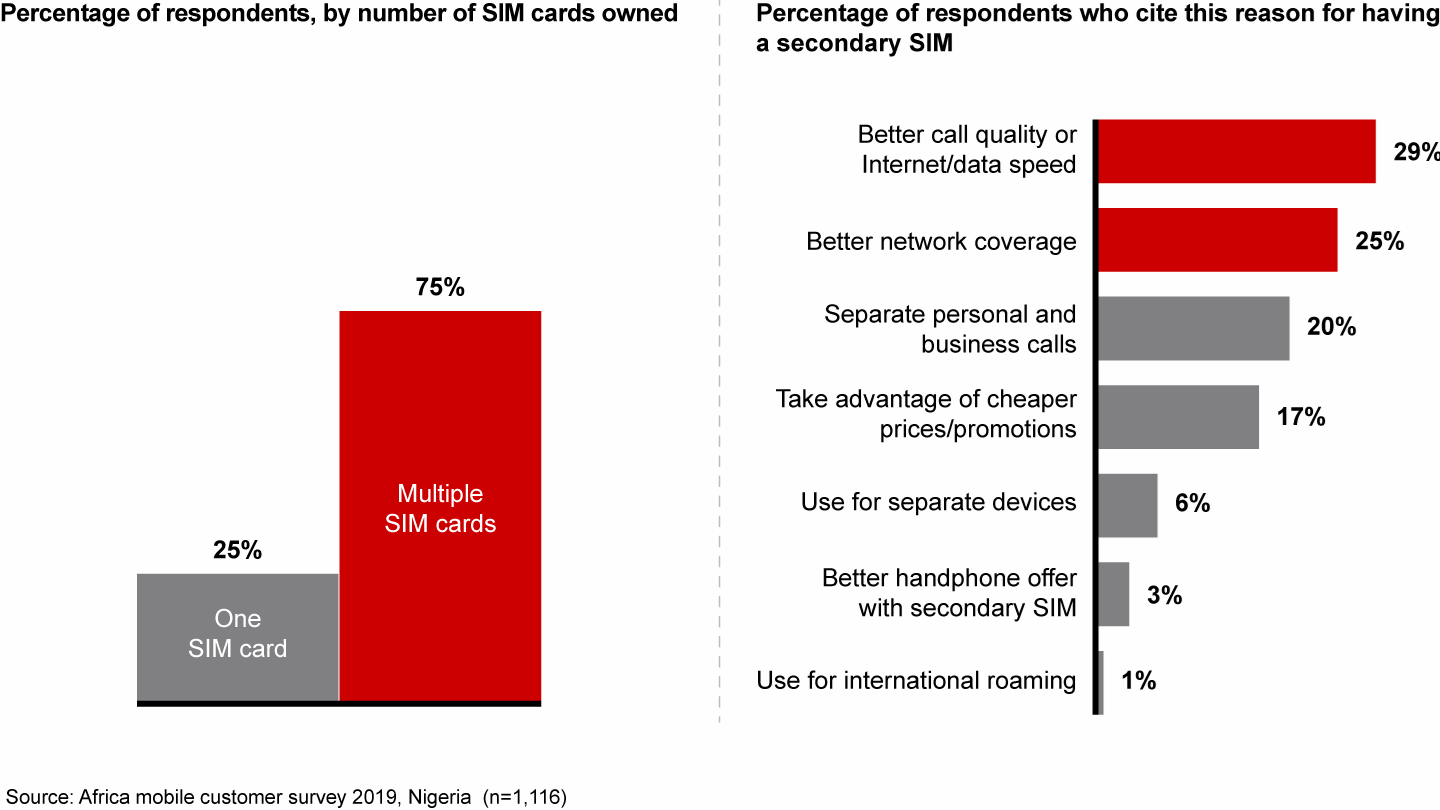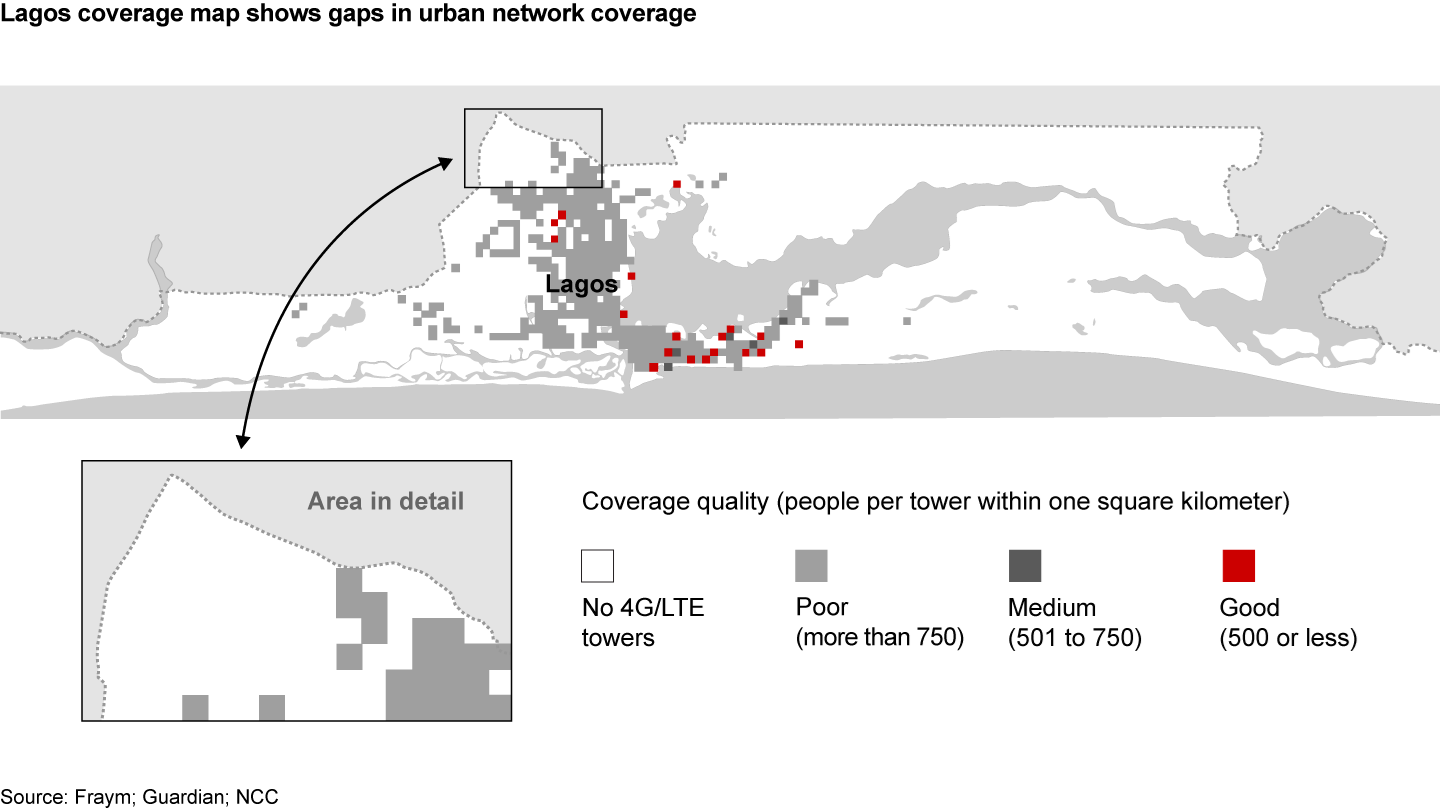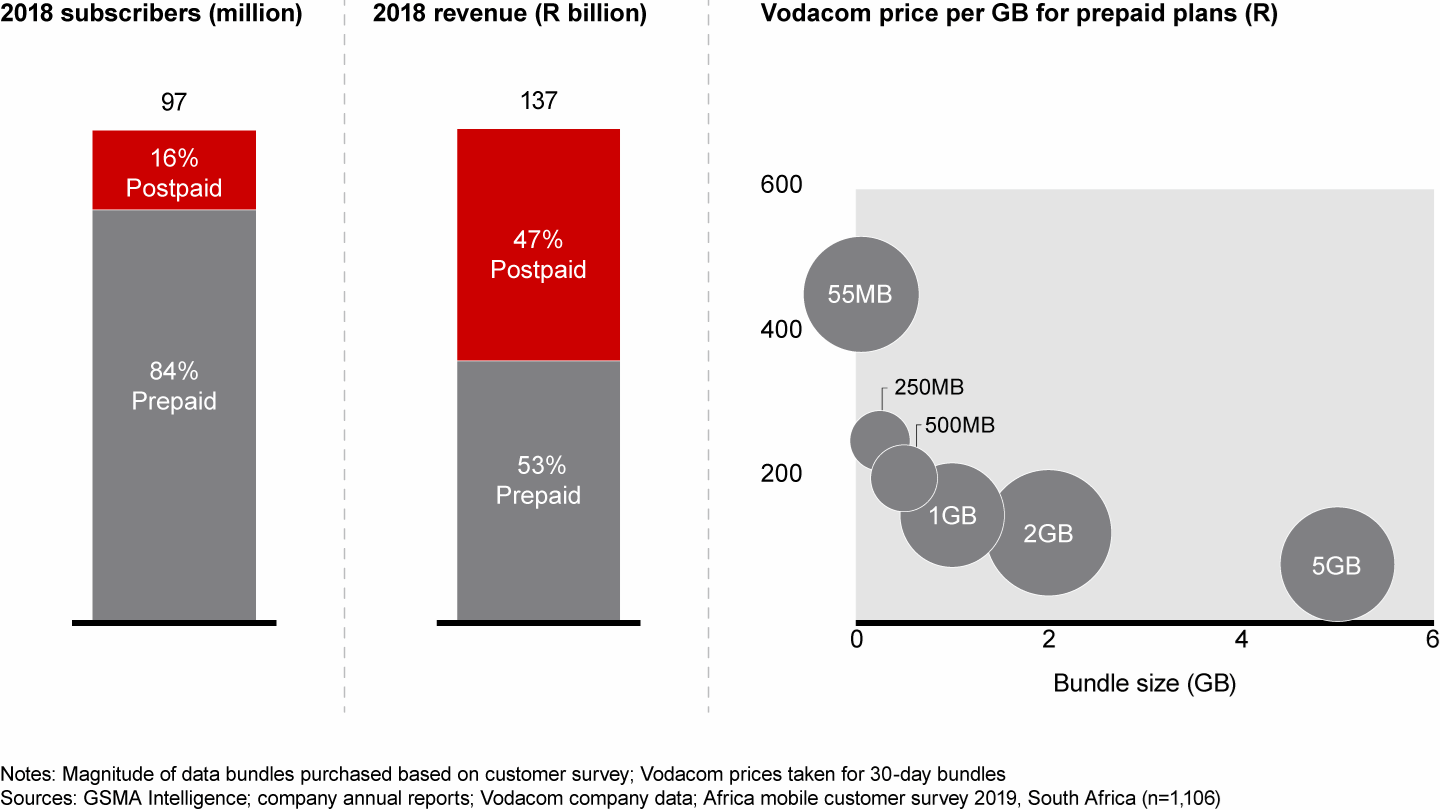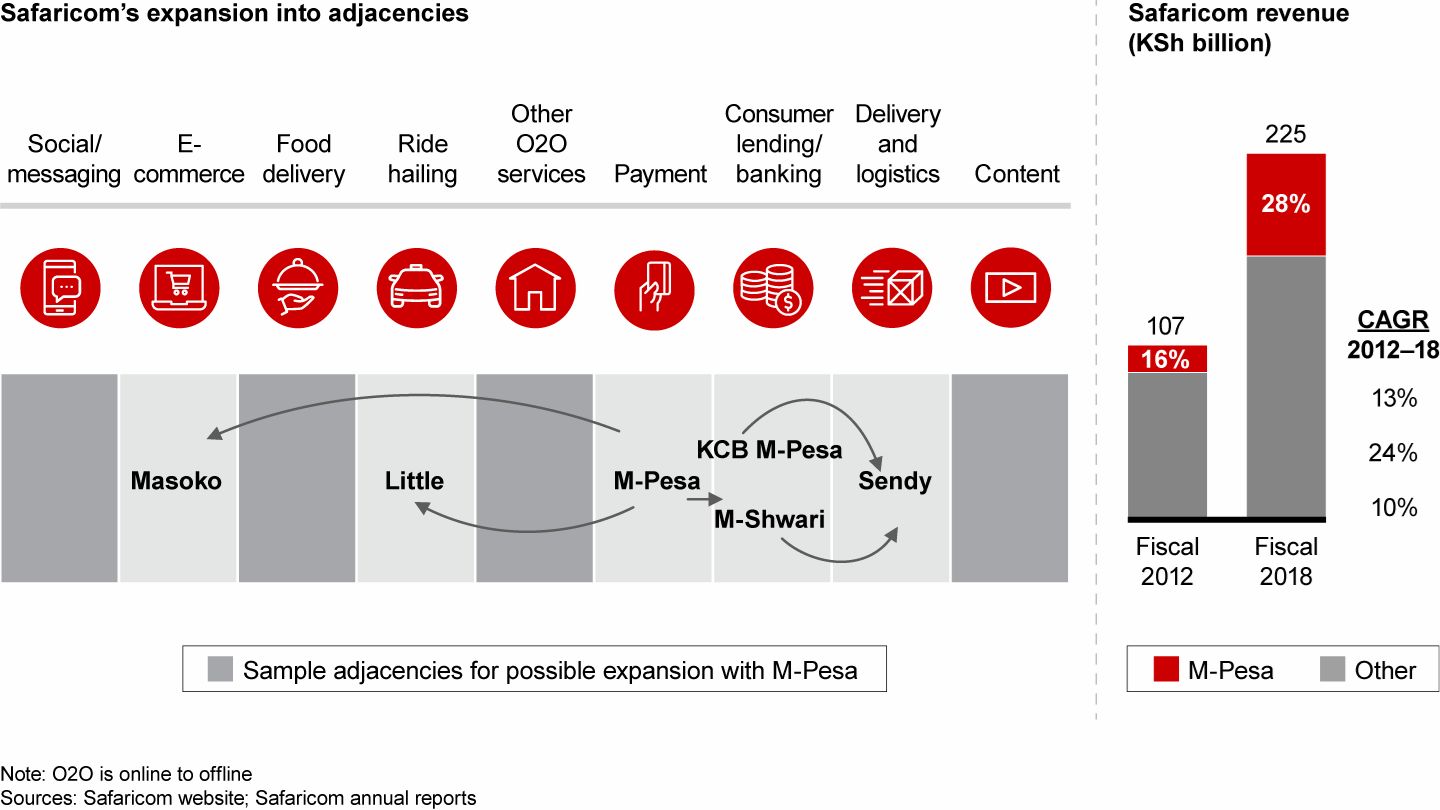Brief

한눈에 보기
- As the Sub-Saharan Africa mobile market matures, consumers are focusing more on quality than price, and more on social media, video and messaging than voice.
- Recurring mobile revenues in the region could decline as much as 5% over the next five years unless operators change course.
- Telcos need to adopt a strategy that elevates the customer experience over pricing and products.
- Nations in focus: Nigeria, South Africa and Kenya each face different challenges.
Mobile phone operators in Sub-Saharan Africa (SSA) are playing on borrowed time. Robust network investments, cheaper smartphones and data, and a rapidly expanding population of connected youth have fueled strong growth for the US$60 billion SSA mobile market. But as the market matures, operators risk falling into the “doom scenario” that has plagued their counterparts around the globe: saturated markets, an uneven response to evolving consumer preferences, and falling revenues.
The SSA mobile market is changing, and fast. In this new landscape, mobile customers are more concerned with network quality than prices. Moreover, video content, social media and messaging are replacing voice for how people communicate, buy and sell goods, and conduct banking.
SSA telcos have responded slowly, and customers are taking note. A Bain & Company survey of thousands of mobile customers in Nigeria, South Africa, Kenya, Ghana and Ivory Coast found that customers are increasingly dissatisfied with mobile service quality. In some markets, notably Nigeria and South Africa, consumers regularly swap out SIM cards to chase better networks or value. Collectively, operators’ low Net Promoter Score® (a measurement of satisfaction and loyalty) affirms that they are falling short of transforming customers into advocates.
SSA operators are hitting the same headwinds that have already buffeted more mature markets: average revenue per user (ARPU) rates are declining and subscriber growth is slowing. For example, from 2013 to 2018, traditional voice revenues in South Africa declined by about 10% as data applications are substituting for voice. And while mobile data prices in the SSA region are higher than in other markets, the growth from data is not enough to compensate for the loss in voice revenue. In addition, market saturation and pricing wars have created a race to the bottom, in which operators can no longer compete based on low-cost offerings alone. As a result, SSA recurring mobile revenues could decline as much as 5% over the next five years unless operators change course.
The writing is on the wall: What worked for the past 10 years will not be sustainable for the next 10. To succeed in the coming decade, telcos’ product-based approach that offers basic services must shift to a customer-centric strategy that focuses on investments in the customer experience. Based on our on-the-ground research into customer mobile usage and preferences in the region, we have identified three questions that operators need to answer in order to win in this rapidly changing landscape:
- Network or devices? Thoughtfully grow your market
- Price or experience? Deeply understand customer needs
- Operator or innovator? Play to your strengths
Telcos that make the right choices now will be better positioned to win over the long term.
Network or devices? Thoughtfully grow your market
Network quality is the most important purchasing criterion for mobile customers in the SSA region, our research found. Thus, investing in strong network coverage and capacity is fundamental to driving higher data-driven ARPUs. But growing the market cannot rely on an “if you build it, they will come” strategy. SSA operators must also provide access aggressively. This requires a two-step approach: expand coverage with a good network and get more smartphones into the hands of customers (see the sidebar “Nigeria: The time is right to grow the market” below).
Invest in a world-class network. To create the right conditions for growth, operators must first improve network coverage and capacity through targeted, demand-based investments. This will improve the customer experience on digital platforms, which will boost data-driven ARPUs. Our research confirms that focusing these investments in high-demand areas, such as urban and periurban locations where customers have middle to high disposable income, can reduce the payback period to about three years.
Increase smartphone penetration. A world-class network is useless if customers can’t access it. Therefore, telcos need to invest in getting more 4G-enabled smart devices into customers’ hands. In price-sensitive markets, the cost of a smartphone or data device is a major barrier to entry. Overcoming this hurdle may require operators to adopt a “give them the razor, sell them the blade” approach by marketing branded, low-cost or refurbished devices and subsidising 50% or more of the cost in return for a lock-in period. The profitability of such a strategy will hinge on getting the right data devices to the right customers based on usage.
The challenge for operators will be ensuring both elements are balanced. A strong network without enough devices will erode the return on investment. Likewise, channeling more devices into the market will degrade the customer experience if the network cannot keep pace with demand. Telcos will need to start with the network, provide the right number of devices, and manage demand and usage for the best customer experience.
Price or experience? Deeply understand customer needs
As the mobile market matures in the SSA region, price alone cannot win over—and more critically, keep—customers. Operators can claim additional value if they maximise customer spending. We believe SSA operators can achieve this if they simplify their postpaid offerings, personalise their prepaid offerings, and deliver a best-in-class customer experience.
This will require a fundamental shift in strategy. Poor Net Promoter Score performance and our own research reveal wide dissatisfaction with customer service that cuts across all markets and demographics. Telcos have been slow to digitalise, which has created systemic pain points in the customer journey. And the market is predominantly prepaid, making it susceptible to SIM swapping and churn. Operators will need to give customers a reason to make the switch to—and stay on—their platform.
Simplify postpaid offerings. The strategy is clear for operators that want to lift postpaid revenues: Make it painless to switch and hard to leave. Customers do not want to feel like they need an advanced degree to navigate, select and activate the right plan for them. To maximise customer lifetime value in this segment, operators need to focus on streamlining packages and offering a clear value proposition for each. From there, companies can deploy family plans, reduced incremental costs and other strategies to build a community of users that locks customers in.
Personalise prepaid offerings. Loyalty is typically transactional for prepaid subscribers. But operators can improve stickiness—and end the revenue-eroding SIM-swap game—with microsegmentation. By using machine learning and analytics gleaned through usage data, telcos can create highly customised packages that align with each customer’s willingness to pay (WTP). Calibrating WTP with mobile data needs will enable operators to offer the right amount of data at the right price at the right time. Pushing deals that customers truly value could nudge more prepaid customers to convert to postpaid subscriptions—or at the very least, encourage them to adopt postpaid behaviours.
Deliver best-in-class customer service. Both strategies must be coupled with processes and procedures that eliminate pain points for customers. Our research has found that technical support and billing issues are the top sources of complaints after activation. Many of these issues can be addressed by embracing digitalised services that empower customers to find and act on information when they need it. For example, best-in-class global telcos and even some local operators, such as Rain in South Africa, have started to adopt a predominantly digital customer interface. Well-designed apps that can handle end-to-end processes are another strategy that savvy operators are deploying. By providing customers with a range of self-service tools literally at their fingertips, operators can minimise customer frustration and improve loyalty (see the sidebar “South Africa: Simply and personalise to maximise customer spending” below).
Operator or innovator? Play to your strengths
Operator or innovator? As the mobile landscape evolves, SSA telcos need to decide if their future is in network operations (growing the market through 4G investments and world-class customer service) or in value-added services (such as mobile banking and video streaming). Global players in more developed markets have already proven that operators cannot succeed at both over the long term; there are simply not enough resources to go around. Rather than follow the path of their global peers, SSA operators can make the tough strategic choices now about which archetype they will embrace and invest accordingly.
The operator archetype. The operator archetype is focused on becoming a world-class network operator. In this scenario, operators channel all of their resources into running the infrastructure and providing connectivity services, largely through fixed mobile convergence (FMC) and mobile services. Converging FMC and mobile business will enable operators to bundle services, such as broadband, telephone, mobile and television, which has been proven to increase ARPU and reduce churn. Telcos do not need to build their own FMC infrastructure; rather, we recommend that they expand their capabilities by acquiring existing fibre players.
Operators considering this play should be ready for a winner-takes-all landscape. The SSA region’s individual markets cannot sustain the three to four players that are in place now. Consolidation to one to two players in each market will increase profitability. It will also enable network operators to focus their investments on operating models that drive a higher volume of mobile services.
The value-added services archetype. Conversely, telcos can choose to own the customer rather than the network. This archetype positions operators higher up the value chain to capture and own users through a customer-centric lifestyle platform. Beyond single-use cases such as content streaming, financial services and gaming, operators can own more of each customer's spending by adding and diversifying the current mobile services–reliant ARPU. Creating an ecosystem that provides end-to-end apps will enable operators to mine more value through both transaction and subscription fees, as well as higher data consumption.
This is an attractive option for telcos, largely because they have a ready-made platform for capturing more customer spending. They have the means to create 360-degree profiles of their customers, providing data that companies can collect, act on and monetise. Mobile money in particular provides a “super app,” or entry point, for operators to expand into other adjacencies, as Safaricom found with M-Pesa (see the sidebar “Kenya: Innovation is the key to the future” below). But it is by no means the only entry point. Operators need to determine the right super app for their customer base, which they can then use to expand into other adjacencies.
Adapting to a new state of play
To achieve the full-scale transformation that will be required to play in this evolving market, telcos first need to look inward. That may seem counterintuitive for developing a strategy that elevates the customer experience over pricing and products. But operators have to determine where they are before they decide where they want to go.
Operators can start by running a full diagnostic on the state of their operations, using a customer-centric lens. Where are their core competencies strongest? Are they strategically deploying resources to support the right capabilities? Where are they falling short on delivering a best-in-class customer experience? Where should operations be strengthened—and where should they be streamlined? Tools such as the Net Promotor Score and Bain Capex Impact can reveal insights that will be fundamental to building out a sustainable customer-centric roadmap.
Forward-looking operators must then decide where they want to play: as a utility or as an innovator. Either choice has wide-ranging strategic implications that will influence everything from board membership down to the frontline operating model. In most cases, it will upend how these businesses have been run for decades
No matter which playbook they adopt, SSA operators will need to change their trajectory quickly if they want to stay in the game. By investing in a customer-centric approach, they will be positioned to improve loyalty, reduce churn, grow their ARPU, and capture more spending even as their markets mature. But the time to act is running short, and the doom scenario looms over the horizon. These deep and long-term changes require time, strategic focus and investment—all of which will be scarce if operators wait too long to make their play.
Nations in focus
Nigeria: The time is right to grow the market
Network quality is the No. 1 reason Nigerians switch providers, according to our research. With 50 million to 60 million potential new data subscribers, operators that strike the right balance between network quality and device volume will be well positioned to win in this market.
With an underdeveloped fixed-line network, mobile is the primary channel for communications in Nigeria. Yet network coverage gaps are prevalent, even in dense urban areas. Our survey of mobile users in Nigeria found that roughly 40% of customers use multiple SIM cards as a workaround for network issues (see Figure 1). The high cost of mobile devices are also a significant impediment to improving data-driven ARPU.
Most Nigerian customers have more than one SIM card, largely because of network issues


Operators in Nigeria should focus on strengthening 4G coverage, particularly in urban and periurban areas, where a little over half of the country’s population live. For example, in Lagos, demand is high for 4G coverage, yet the number of 4G towers falls well short of those available for 2G and 3G users (see Figure 2). Operators can deploy a phased approach to introduce branded, 4G-enabled smartphones that get more users on board and keep them there.
Expanding the 4G network will enhance the customer experience on digital platforms, while furnishing low-cost or subsidised 4G devices will enable Nigerian telcos to increase the demand for mobile data. Providing better coverage and improved access will elevate the customer experience, improve customer loyalty and increase operators’ share of wallet by eliminating the need for multiple SIMs.
Nigeria has room to strengthen existing 4G coverage in urban and periurban areas


South Africa: Simplify and personalise to maximise customer spending
South Africa’s market has tremendous potential value for operators that can overcome the country’s high churn and SIM-swapping rates. According to our research, one-third of subscribers in South Africa use multiple SIM cards. The No. 1 reason: a desire to “take advantage of cheaper prices and promotions.” Churn is also three to four times higher in South Africa than in developed markets. In this market, where mobile provider loyalty is up for grabs, telcos should simplify and personalise.
First, South African operators need to improve the experience for their most important revenue contributors: postpaid subscribers. This customer segment accounts for only 16% of the market, but provides nearly half of the revenue (see Figure 3). The top three mobile operators offer more than 20 plans each, yet just a handful of offerings produce the majority of revenue. We recommend that telcos simplify to five packages, each with a very clear value proposition based on price sensitivity and usage. They can then boost customer lifetime value and reduce churn with community packages and a frictionless, digital experience.
Postpaid plans represent 16% of subscribers and 47% of revenues in South Africa; prepaid customers typically buy smaller bundles that cost more per gigabyte


Converting a significant percentage of prepaid customers to postpaid subscribers is not likely in South Africa, where income is unstable for many customers. Instead, operators need to focus on fostering postpaid behaviours by offering tailored short-term offerings that are based on real-time analysis of usage data. Operators can expand from there, analysing long-term trends to push recurring bundles that encourage stickiness and reduce churn. Our research suggests that reducing prepaid SIM swapping and tailoring offerings to lock in usage can boost revenue another 3%.
Kenya: Innovation is the key to the future
As one of the most mature mobile markets in the SSA region, Kenya is ripe for innovators to expand their customer base and capture additional spending by investing in value-added services. For telcos in Kenya, the foundation is in place. They now need to explore their core capabilities, define a strategic path that builds on those capabilities, and invest in solutions and partnerships that will bring the most value to their customer base.
In this market, value-added service operators need to build fully functional end-to-end platforms to capture more customer spending. If they do not, someone else will. That is the play that market leader Safaricom is making. The company is using its vast network and dominance in mobile money as an entry point into adjacencies, such as e-commerce, logistics and financial services. M-Pesa, a mobile banking service created by Safaricom, accounts for 70% of all electronic transactions in Kenya and more than one-fourth of Safaricom's revenues (see Figure 4.) This business, however, could be affected by a proposal in the Kenyan Parliament that would separate mobile-money services from telcos.
The M-Pesa “super app” now generates 28% of Safaricom’s revenues and provides a platform for further expansion


Innovators would also be well served to invest in content to drive up data consumption and increase ARPU. Our research shows that Kenyans are expected to consume up to 40% more data in video by 2022; the paid-video market is expected to grow by approximately 6% in the same period. To effectively monetise content, Kenyan operators should focus on the distribution of content and invest in exclusive content rights. Innovators could also target underserved populations, such as rural farmers, with digital solutions that address obstacles to access.
Acknowledgements
The authors would like to thank the Bain & Company Africa partner group for supporting this initiative, and recognise the manager, Prashanth Gubbala, the working team—Matthew Howard, Yandisa Kewana, Robert Reed, Tomi Amu, Fatima Docrat, Hilde Herman—and other key contributors—Nicola Wilson, Bain Editorial and the rest of the Bain & Company team, which made significant contributions to the research.
With special thanks to Fraym
With special thanks to Fraym
The authors are grateful for the contributions of Fraym, a geospatial data company that uses proprietary machine learning algorithms to deliver precise, local-level information about people in Africa, Asia and Latin America. The company helps fast-growing companies, government agencies, and development organizations succeed in places where data has been traditionally hard to access.
Methodology
We received 5,346 responses across five target countries, with 1,116 responses from Nigeria, 1,106 from South Africa, 1,032 from Kenya, 1,074 from Ghana and 1,018 from Ivory Coast. Responses were collected using the survey method, with 70% collected through in-person intercepts and 30% through online surveys. The in-person intercepts were primarily conducted in urban areas with high foot traffic, such as malls. The responses were collected across all income levels, in close alignment with the relevant distribution in each country.
Bain Africa
Bain Africa comprises our Johannesburg and Lagos offices. We serve a broad range of clients across the continent’s largest, most rapidly changing sectors. Since 1997, we have collectively completed more than 350 projects throughout Sub-Saharan Africa, and our diverse client portfolio includes multinational organisations, JSE Top 40 firms and state-owned enterprises. Our consulting and pro bono work supports the continent’s broad transformation agenda, and we are proud to be a Level-3 B-BBEE contributor.
Bertrand Fallon-Kund is a partner with Bain & Company’s Telecommunications, Media and Technology practice and is based in Johannesburg. John Senior is the managing partner of Bain’s Johannesburg office and a member of the Digital and Telecommunications, Media and Technology practices. Stephane Timpano is the managing partner of Bain’s Lagos office and a member of the Telecommunications, Media and Technology practice.
Net Promoter Score®, Net Promoter System®, Net Promoter® and NPS® are registered trademarks of Bain & Company, Inc., Fred Reichheld and Satmetrix Systems, Inc.